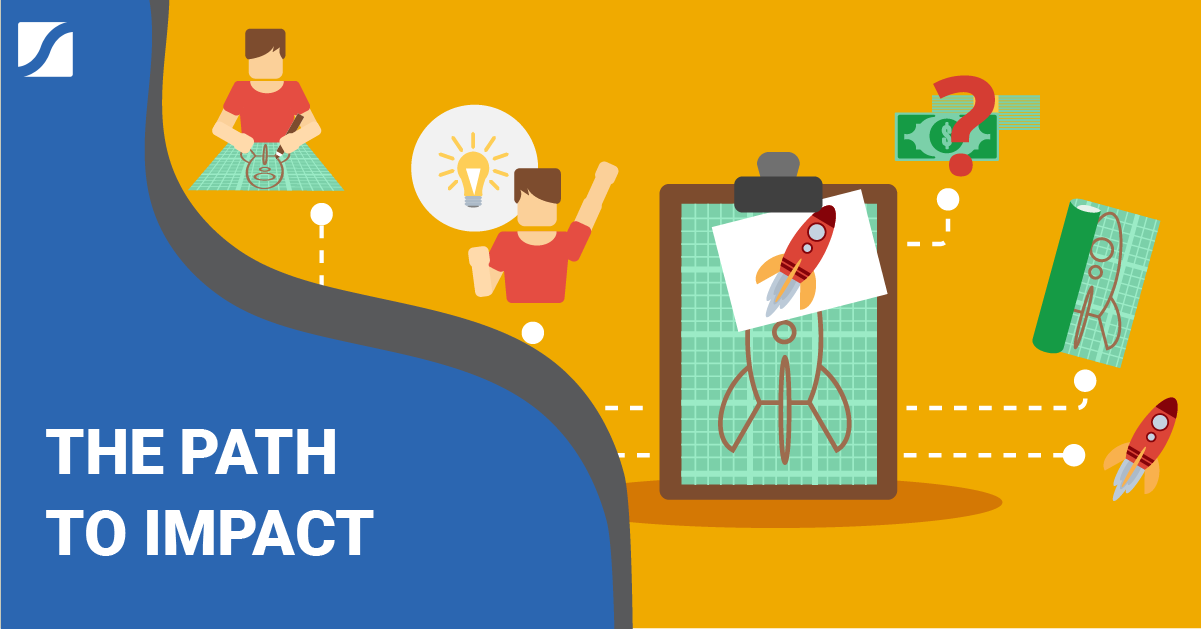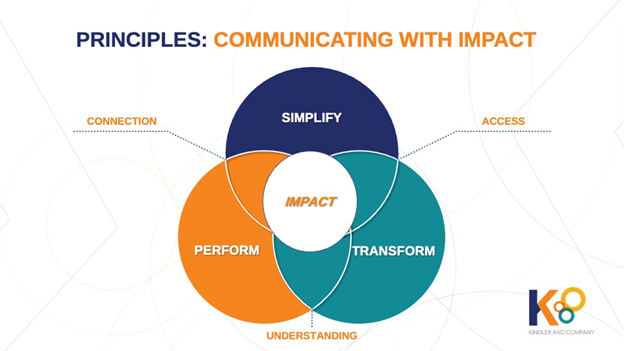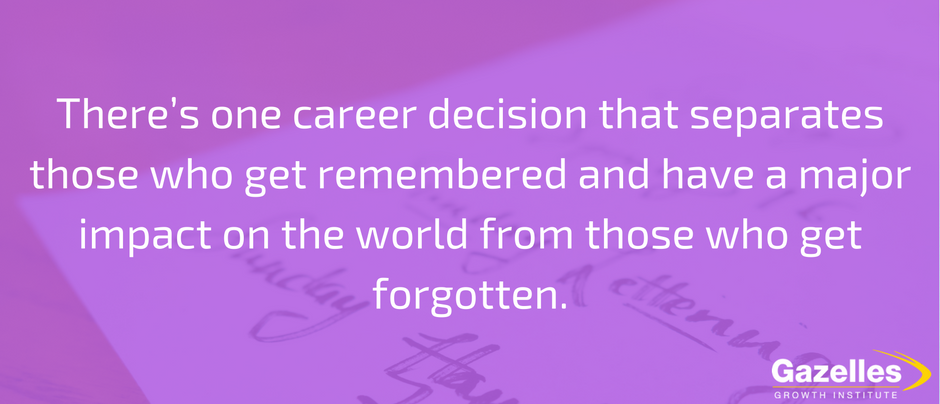The Path To Impact


Not long ago I was coaching a young regenerative research scientist named Laura, helping her develop a talk based on her research.
Laura, like many regenerative scientists, was focused on a tiny little problem: developing a cure for diabetes.
We were stuck. I was having a hard time getting her to articulate the purpose of her talk. She kept telling me, passionately, about specific readings and measurements, which, as I am not a regenerative scientist, didn’t mean much to me.
When I asked her to explain the purpose behind the readings and measurements, it made even less sense.
We had a limited number of sessions and I wanted to get some traction.
So, I decided to change things up. I asked her, “Tell me about your work day. What happens from the moment you wake up to the moment you close your eyes?”
She told me that after she finishes her morning routine of exercise, breakfast, and so on, she arrives at her lab at around 7:30 and checks “the readings and measurements to ensure that nothing has changed overnight and that the regenerated pancreas... ”
“Sorry, can you repeat that last part?” I wanted to make sure I hadn’t misheard.
“I check the readings and measurements to ensure that nothing has changed overnight and that the regenerated pancreas... ”
Smiling, I asked her, “Are you saying that you have actually regenerated a pancreas?”
“Yes.” She looked at me like I was joking.
“I didn’t know that was possible.”
“Oh yes, sure it is. That has been happening for a while now,” she said smiling. “The challenge isn’t regenerating the pancreas; it’s vascularizing the body so the pancreas will be accepted and work within the body successfully. That’s what I am working on.”
And just like that—a breakthrough! For Laura and me, at least. Her work continues.
This is where we focused. Because if Laura and her team can successfully vascularize a pancreas, the part of the body that produces insulin, she can help find a cure for diabetes, which caused 1.6 million deaths in 2016.
Laura’s work is important. She just didn’t know how to express herself.
Communicating Clearly And With Impact
I would argue that your work is important too.
Replace regenerative scientist with your job title: financial advisor or environmental response coordinator or dermatologist or ophthalmologist or information systems director.
The world of work, no matter what you do, has become more and more complex. Do you understand the impact your work can have on the world? Do your teams, your clients, and your community? Do they even understand what you do?
Although many of us have heard of blockchain, most of us don’t truly understand what it is. And while we all have heard of regenerative medicine, did you know that we can actually regenerate a pancreas?
When I ask this question in my talks and workshops, 90 percent of people say they had no idea this kind of innovation had become a reality. And that’s a shame, because we are very close to solving some of the world’s biggest problems. We should know this.
I think it’s fair to say that we all, regardless of our job title, want to have an impact in our work, in our community, in our home. And we can.
But we need to be able to wade through the complexities of our work and the supportive technologies in order to communicate clearly.
The good news is that this is possible. There is a model that will help you, your math genius neighbor, or your rocket scientist/socialite friend communicate with impact.
I call it the Path to Impact and it contains three simple principles
As leaders we must simplify our messaging so it’s accessible. Then we must transform the message. Take the communication in its simplified form and transform it so your audience can understand it and relate to it.
And from there, we take our transformed content and perform it with confidence and style so we can connect and engage with others.
If we simplify, we will provide access to those who normally would not be exposed to the content. If we transform, we will help people understand. If we perform, we will create engagement. In doing so, we will have a real impact.
It’s more than just a pretty picture. The Path to Impact model works. It has been embraced by scientists and speakers and educators and entrepreneurs and business leaders from Amsterdam to Toronto and from Brazil to Italy, from blockchain experts to those seeking economic reform.
The model helps them clarify their message and engage powerfully with their audience.
Your Idea Matters
Ideas are like rivers. They start as a trickle somewhere far off. High up on a mountaintop, ice and snow melt and join that trickle and it slowly builds and flows down, down, down.
Slowly but surely the waters come together and move from way out there into the world until they finally get to you.
Your idea is starting somewhere far off, high up within you. Perhaps it’s tucked away in the recesses of your mind. Perhaps it’s in a file folder or a notebook or an email on your phone. Or perhaps it’s on a cocktail napkin in the glovebox of your car. It’s there. It’s waiting.
Here’s the thing: if you have an idea that you think has potential and you don’t share it with the world... well, shame on you!
Ideas have tremendous power and potential. Steven Spielberg once said, “All good ideas start out as bad ideas, that’s why it takes so long.”
Although he didn’t write many of his blockbuster movies, imagine a world without E.T. or Jaws because Spielberg decided “Nah, a big shark is too silly,” or “An alien that befriends a kid is stupid.”
Let’s take it further. Imagine a world where no ideas get shared. Nothing.
This is a world of stasis. Where innovation and change and creativity don’t exist. A world where penicillin was never invented. A world where the Mona Lisa was never painted. Where the musical Hamilton was never produced. Where Queen’s “Bohemian Rhapsody” never hit the airwaves. All because those brilliant creators kept their ideas to themselves.
Ideas are the lifeblood of innovation. They require risk, collaboration, and flexibility, as well as a dose of both humility and conceit.
Not long ago, I was working with a brilliant leader in the area of energy.
Jane Kearns is the head of energy at MaRS, one of the world’s foremost accelerators and incubators for innovation. Jane has helped dozens of companies in the energy sector move from business idea to successful enterprise, and in 2018 she joined me at one of my speaking intensives designed to take leaders from idea to polished talk in a few very busy days.
She was there to learn how to become a better speaker and she thought she might be able to share her learnings with the companies she mentors.
At dinner after the first day, I told her I thought she had a tremendous amount to offer the world as a speaker on renewable energy. She laughed and replied glibly, “I am not the one you would want for that. I would go to Tom Rand first. But thanks.”
I told her I know who Tom was (an excellent speaker and one of the foremost experts on renewable energy) and had seen him speak, but I knew she could be like Tom, only better. “I think you’re selling yourself short.”
Jane smiled and said, “Well, I mean, I am not really an expert. I mean, Tom is the expert.”
I politely asked her to tell me about her experience in the energy sector. She could see where this was going, but she went along with it. She told me about her years spent as a venture capitalist in New York. She talked about her time in the energy industry working with some of the most leading-edge companies in the world and how she had helped them articulate their value and grow.
As she spoke, she could easily explain not just the complicated technology the company had invented but also the complex environmental problem it solved. Within a few minutes, she had outlined a massive amount of content that would provide incredible value to audiences around the world.
I pointed this out and said, “You are right. You are not Tom Rand. You are different. You are better.”
A few months later, Jane became a faculty member at SingularityU Canada and began speaking around the globe to business leaders about exponential technologies and the future of energy technology.
Many of us are like Jane. We are afraid of putting ourselves out there.
As Marianne Williamson wrote in A Return to Love, “Our deepest fear is not that we are inadequate. Our deepest fear is that we are powerful beyond measure. It is our light, not our darkness, that most frightens us.”
We think, It’s not good enough. It doesn’t make sense. I am not smart enough. No one will listen to me.
These thoughts are dangerous. They kill innovation and opportunity. So, let’s do the following. Let’s recognize these thoughts, welcome them to the meeting, and then keep them in a separate breakout room... indefinitely.
Your small ideas must be shared so they can transform from a trickle into a current and from a current into a wave. A wave that can change the world.
My friend and client Floyd Marinescu started a wave. He’s a successful CEO running C4Media, which offers content and education conferences for software development gurus.
Floyd was already extraordinarily successful when I met him five years ago, but he was frustrated. He saw the proliferation of AI and automation, which was helping him grow his business and become wealthy, but it was also exacerbating a massive income gap in society. Floyd had come from a working-class family with limited means and had seen the impact of globalization and automation on his father, a tool and die machinist who had lost his job in the 1980s.
Floyd wanted to speak about his big idea: basic income.
Basic income provides all members of society with a low level of income so we can operate with freedom to develop, build, or work without the constraints of keeping the lights on. The fundamentals of food and board are covered by society. It wasn’t a new idea, but Floyd was passionate about it. He also worried, “Who am I to share this message?”
I asked, “If not you, then who?”
I worked with Floyd for about two years. I helped him develop several different talks.
He spoke at libraries full of concerned citizens, he met with politicians, he spoke on TV and delivered a successful TEDx Talk. Over those two years, he spoke dozens of times and started a CEOs for Basic Income group, proving that this was an idea that could be embraced by those worried about the health of capitalism.
Politicians reach out to him, and quote him, regularly. He has become a recognized thought leader on basic income.
Like Floyd’s ideas, your ideas matter. Your ideas are worth sharing. Your ideas cannot just change your world: your ideas can change everyone’s world.
If not you, then who?



%2016.55.51.png)
